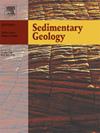Late Quaternary oceanographic controls on sediment distribution and transportation in the Southeast Indian Ocean; insights from IODP Site U1516
IF 2.9
2区 地球科学
Q1 GEOLOGY
引用次数: 0
Abstract
The Late Quaternary is a crucial period marked by glacial-interglacial cycles that significantly impacted global paleoceanography and paleoclimate, making the reconstruction of terrigenous input in the southeastern Indian Ocean vital for understanding these shifts. We present a terrigenous sediment record from International Ocean Discovery Program Site U1516 in the offshore Mentelle Basin, reconstructing sediment provenance, transport mechanisms, and paleoclimate variability over the last 766 ky (MIS18-1). Grain-size analysis reveals a silt-dominated assemblage, with median grain size coarsening during glacial periods, reflecting enhanced winnowing of fine particles, while elevated clay concentrations suggest greater resistance to winnowing and increased supply from shallow shelves due to sea-level decline. Clay mineral assemblages show dominance of kaolinite and illite during interglacials, contrasting with peaks in smectite and chlorite during glacials. These patterns are attributed to sources in southwestern Australia transported by the Leeuwin Current, which delivered more kaolinite and illite during intensified interglacials and shifted to finer-grained smectite during weakened glacials. Elevated chlorite during glacials likely derives from deep marine settings south of Australia or Antarctica, transported via Antarctic Intermediate Water and Leeuwin Undercurrent. This variability highlights glacial-interglacial shifts in sediment routing tied to ocean circulation changes. Contrary to earlier observations of ‘dry glacials’ in southern Australia, data from Hole U1516B (illite crystallinity, chemical indices) reveal the presence of both wet and dry periods during glacials that were previously assumed to be solely dry, aligning with speleothem records but conflicting with bulk geochemical interpretations. This highlights the need for proxy-specific calibration. Interglacial periods also show intensified wetter intervals similar to those during glacials. These glacial-interglacial wetter intervals are likely driven by latitudinal shifts in the Southern Hemisphere westerly winds. This study provides new insights into glacial-interglacial transitions, linking oceanic circulation shifts, sediment transport dynamics, and hydroclimate variability in southwest Western Australia.
晚第四纪海洋学对东南印度洋沉积物分布和运移的控制来自IODP网站U1516的见解
晚第四纪是冰期-间冰期旋回对全球古海洋学和古气候产生重大影响的关键时期,因此重建印度洋东南部陆源输入对于理解这些变化至关重要。本文介绍了国际海洋发现项目U1516在Mentelle盆地近海的陆源沉积物记录,重建了过去766天(MIS18-1)的沉积物来源、运输机制和古气候变率。粒度分析揭示了一个以粉砂为主的组合,在冰期中位数粒度变粗,反映了细颗粒的筛分增强,而粘土浓度的升高表明对筛分的抵抗更强,并且由于海平面下降而增加了浅海架的供应。黏土矿物组合在间冰期以高岭石和伊利石为主,在冰期以蒙脱石和绿泥石为主。这些模式归因于Leeuwin海流在澳大利亚西南部的来源,在间冰期强化时,高岭石和伊利石更多,在冰期减弱时,滑脱石向细粒滑脱石转移。冰期升高的绿泥石可能来自澳大利亚或南极洲以南的深海环境,通过南极中间水和Leeuwin暗流输送。这种可变性突出了与海洋环流变化有关的沉积物路径的冰期-间冰期移动。与早期对澳大利亚南部“干冰川”的观测相反,来自U1516B洞的数据(伊利石结晶度,化学指数)显示,在以前被认为完全干燥的冰川期间,存在湿期和干期,与洞穴记录一致,但与大量地球化学解释相冲突。这突出了对代理特定校准的需求。间冰期也表现出与冰期相似的强化湿润间隔。这些冰期-间冰期的湿润间隔可能是由南半球西风的纬度变化所驱动的。这项研究为西澳大利亚西南部的冰期-间冰期转变提供了新的见解,将海洋环流转变、沉积物输送动力学和水文气候变率联系起来。
本文章由计算机程序翻译,如有差异,请以英文原文为准。
求助全文
约1分钟内获得全文
求助全文
来源期刊

Sedimentary Geology
地学-地质学
CiteScore
5.10
自引率
7.10%
发文量
133
审稿时长
32 days
期刊介绍:
Sedimentary Geology is a journal that rapidly publishes high quality, original research and review papers that cover all aspects of sediments and sedimentary rocks at all spatial and temporal scales. Submitted papers must make a significant contribution to the field of study and must place the research in a broad context, so that it is of interest to the diverse, international readership of the journal. Papers that are largely descriptive in nature, of limited scope or local geographical significance, or based on limited data will not be considered for publication.
 求助内容:
求助内容: 应助结果提醒方式:
应助结果提醒方式:


